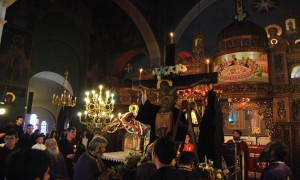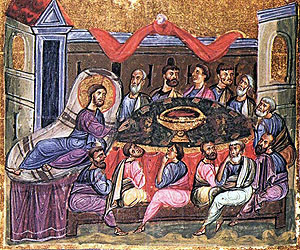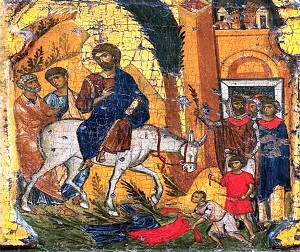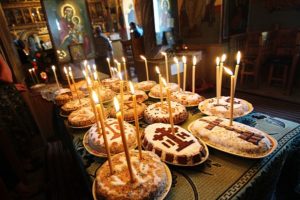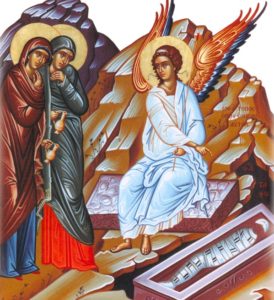The Challenge of Liturgical Translations
22 October 2015The following summarizes and expands commentary on the crucial question of liturgical language, which has appeared in DOXA Magazine in a number of issues.
Liturgical language is an important issue for the members of our monastic brotherhood. It would of course be ever so easy, though not very open-minded or fair, to write off this concern as “mere traditionalism.” Our concern in fact is not one of mere conservatism or some sort of mindless traditionalism, nor is it a question of competition between “Old English” and “Modern English.” The liturgical language challenge is not an old versus new issue at all: It is a question of quality. Neither is the issue whether authentic Orthodox Tradition includes “holy languages” — the answer is that it probably doesn’t. But the Orthodox Faith definitely does require in the Liturgy holy language in the sense of liturgical compositions set apart by the highest quality from that which is ordinary. Some seven-hundred and seventeen thousand days of Orthodox history speak out in unison as witnesses in favor of that claim.
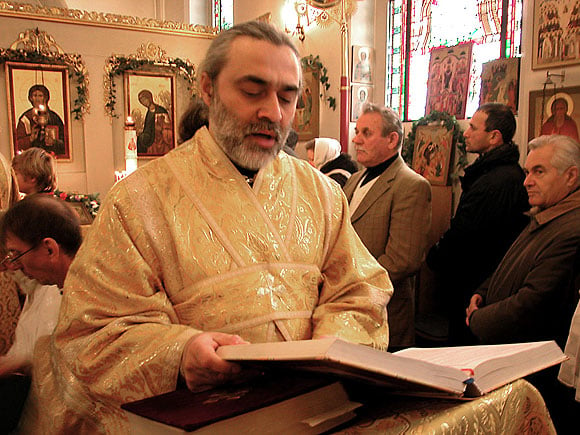
Liturgical language, the sacramental word, is nothing less than verbal iconography. A verbal icon, that is, a liturgical text, like any other icon, must be holy — it must be set apart by respect-inspiring boundaries. The many and varied veils and covers used in Orthodox worship, from the iconostasis and vestments to the chalice veil and the curtains on the Royal Doors, at one and the same time both reveal (“re-veil”) and conceal, thereby eliciting our reverence. The verbal icon must also be “veiled,” that is to say, it should be decently and appropriately clothed in excellent poetic and artistic language. Of course this language must be understandable. That is not at issue. But the language of liturgy should also appeal to the senses, speak to the heart, and engage the mind of the worshiper. And like any other icon, the liturgical text must be kalos, a work of beauty, as well as an accurate translation faithfully representing its original. Anything less is not “adequate” (Greek, prepei), that is, suitable, appropriate, to the Orthodox Faith.
Throughout the Orthodox jurisdictions in this country people are innocently parroting a trendy notion about liturgical language which has invaded the Church from non-Orthodox sources. We are speaking of the erroneous idea that the quality of liturgical language is of no consequence — the only issue is that people should be able to understand, without the least bit of effort, what is being said in the Liturgy. Let us repeat: Understandability is indeed a basic concern, but not the whole picture. Understandability by itself is not enough.
The idea that the quality of liturgical language counts for little reflects, among other things, current American pandering to the lowest common denominator, a perversion of the democratic ideal which has made our public education system among the worst on earth. In the Church this pandering takes on populist overtones worthy of Huey Long or George Wallace when people are informed, in so many words, not to pay attention to those high brow intellectuals who think the language of liturgy should be exquisitely beautiful, since the authentic Orthodox tradition is just to use plain old everyday speech in worship. The latter assertion is simply not true. To borrow a classic 16th-century line, it is a fond thing, vainly invented, and grounded upon no warranty of history. And when did love of beautiful language in the Liturgy become the exclusive property of “high brows,” anyway?
It should not go without notice that the greatest promoters of pedestrian translations among the heterodox have been those who abhor the traditional dogmas of Christianity, who believe doctrines are merely personal opinions, and whose view of Christ is far from that of the Holy Tradition. Among their number we find also the denominational leaders, Protestant and Roman Catholic alike, most influenced by, and who most propagate, a secular humanist interpretation of Christianity. The latter clearly have a socio-political agenda in moving radically away from traditional language. They know this helps wean people off “undesirable” traditional values — i.e., values that don’t square with the current values of “liberal” thinking.
Even though these men and women are native speakers of the English tongue, a large number of them have scant respect for their English-speaking cultural and literary inheritance. Their pronouncements betray a bizarre penchant for cultural self-scuttling — they apparently believe our common Anglo-Saxon heritage is to be despised. Now openness to, interest in, and respect for other cultures and languages is one thing, but that’s a far cry from a compulsion towards sui-genocide! Among all the peoples of the earth, this leaning towards cultural and linguistic self-depreciation is apparently unique to the English-speaking nations, especially the United States of America. One certainly finds no parallel tendency among, say, the Greeks, the Russians or the Arabs, the French, the Germans, or the Latin Americans — in those societies, high and low, rich and poor, native born and naturalized, one with another, they unanimously hold their respective cultural, linguistic and literary inheritance in the greatest esteem.
The pervasive influence in education of self-hating Anglophones has contributed greatly to the current extreme weakness of general English literature programs in our schools, at all academic levels. It has also contributed significantly to the pathetic liturgical adulteration experienced by the Western denominations in this country. A Liturgical Movement which began some thirty-five years ago with a clarion call to the corporate participation of the People of God in the glory of liturgical worship and the beauty of holiness, quickly degenerated into a celebration of the banal. The liturgical use of common everyday English was supposed to create across the board renewal, but the history of those denominations where the change was instituted has been far from encouraging — church attendance and financial support, for instance, have dropped radically, as much as one third or more in some churches. On the other hand, the fastest growing denominational Christian bodies are conservative groups which continue to use the King James Bible. In addition, the fact that the Book of Mormon is written in “King James English,” doesn’t seem to be slowing down Mormon missionary success one bit. In all these cases, there is without any doubt a significant degree of correspondence between the quality and type of language used in Scripture and worship, and the temporal health of the institution.
There are, of course, a number of Orthodox Church members well-grounded in the Faith, whose personal Orthodoxy is beyond question, who favor modern translations. But what sort of modern translations are suitable? The foregoing observations, based on solid and abundant evidence, should at the very least incline one to take a sharper look at the language question — for “just any old translation” won’t do, modern or otherwise.
Not far below the surface of the notion that the quality of liturgical language is of no great significance lurk two major theological viruses, in company with a philosophical malady. Operating in clandestine synergy these three, injected into the question of liturgical translations, deliver a damaging dosage of error with destructive results.
The philosophical malady is “Intellectual Darwinism,” the shallow and arrogant belief that the latest trends and the newest ideas or practices necessarily represent the highest evolution of human intellectual development. Of the two theological viruses, one is the minimalism/reductionism which has afflicted theology in the West for centuries, which we have called “merely-ism.” It would have us believe that since language is merely a tool for communicating facts, street English is just fine in church. The other serious theological error is a grave misunderstanding of the Incarnation which we have named “upside-down” or “inverse” Incarnationalism.
Verse 35 of the ancient Western hymn known as the “Athanasian Creed” contains the Orthodox Christian teaching that the Incarnation is accomplished not by the conversion of the Godhead into flesh, but by the taking of Manhood into God. Many modern Christians, however turn that upside-down — they think of the Incarnation as indeed the conversion of God into human flesh, rather than the lifting of human nature into God. Even Arianism had a higher view of Christ, for Arianism at least viewed Jesus as having become deified. But upside-down Incarnationalism in effect looks upon Jesus as God having turned into a man, or as demonstrating that Man is just like God. Upside-down Incarnationalism views the Incarnation as the conversion of God into human flesh, rather than the lifting of human nature into God or, worse yet, that Man is God! In this view Jesus was merely a simple itinerant preacher who showed us that earth is where it’s at, what you see is what you get, and what you get later, if we can still believe in that, will be more of the same.
Inverse Incarnationalism would reduce the life of prayer to a buddy-buddy relationship with the Man upstairs, rather than mystic Communion with the Divine Trinity. One of the primary progenitors of both secular humanism and Marxism, upside-down Incarnationalism not only mistakes social action (however worthy) for eternal salvation and Utopia for the Kingdom of God, but it also equates baseness with sublimity, accepts tawdriness as glory, and confuses crudeness with exaltation. Inverse Incarnationalism views the enfleshment of God as His ultimate seal of approval on the here and now, the provisional, the ephemeral, and the crude. Upside-down Incarnationalism, which pervades almost all the Western confessions, is heretical. Only the “Continuing Anglicans” seem to have made significant strides in freeing themselves from it.
The Orthodox doctrine of the Incarnation views the entrance of Christ into this world not as God’s seal of approval on the base, but as the first movement in the Transfiguration of the Cosmos. The fact that the eternal King of Glory, even the Lord of Hosts, “emptied Himself” (what the Scriptures call “kenosis”) to be born in a stable and laid in a manger, is not a sign that church buildings and all that pertains to worship ideally should be of manger quality. The kenosis of Christ means rather that the Lord Himself descended to be born in a lowly cattle shed precisely that He might initiate, from the bottom up so to speak, the Deification of Man and the Metamorphosis of the whole Creation.
Based squarely on the Orthodox Doctrine of the Incarnation, the Orthodox Sacramental Tradition calls us to offer to God in church the very best we have — good bread and wine, quality olive oil, the best candle wax, gracious architecture, well-executed art work, the most suitable music, the finest language, and so on and so forth. For the Orthodox Church the question of liturgical translations is therefore nothing less than a major issue relating directly to sacramental theology. If that fact is not stressed in traditional Orthodox writings, it is surely because earlier Orthodox liturgical translators and writers took it as a given so obvious to one and all that it didn’t need to be pointed out!
The belief that the Koiné Greek and the Slavonic of the Scriptures and the Liturgy are “just plain old street languages” is an unhistorical fantasy conjured up to serve inverse-Incarnational thinking imported into some Orthodox circles. Yes, Koiné Greek was the Common Greek1 of the ancient world, the business and street language of the Roman Empire. But the language of the Scriptures is Koiné filtered and refined, first century Greek at its very best. That is particularly clear in the Gospel of John. There, even though the grammar and syntax are very much simpler than what we find in classical Greek, the Gospel text is nevertheless artistically complex, intricately organized, replete with double and triple meanings, subtle irony, and myriad mystical allusions connecting the mission of the Lord to Old Testament themes. And all of this is couched in a sublimely poetic and flowing literary style. That is hardly the everyday language of commerce and the streets!
As for Church Slavonic, to create it, two Greek brothers, Saints Cyril and Methodius, literally spent years in monastic seclusion refining the language of the Slavs who lived in the vicinity of their native Thessalonica, which language the brothers had spoken fluently from childhood. The result was a liturgical tongue adequate to Orthodox worship and understandable to all Slavs who knew the basics of the Christian Faith. These Greek Orthodox brothers cared enough for another ethnos, namely the Slavs, to respect their need for a sophisticated literary language. Their Slavic Barbarian beneficiaries in their turn were no fools. For they knew full well that the possession of such a splendid literary tongue would number them among the civilized tribes of the Byzantine Commonwealth, and they gratefully accepted the gift.
It has also been said, so often it has become conventional wisdom, that the language of the King James Bible and the Coverdale Psalter (two of the first translations of Orthodox liturgical material into English), and the Book of Common Prayer (containing a number of Orthodox prayers and hymns) is “merely the street English of the late 16th and early 17th centuries.” That is patently erroneous. As author Robert Claiborne notes in his book Our Marvelous Native Tongue, a great deal of literary “junk” was produced in that era. But the translators of the King James Bible, as well as Miles Coverdale[2] “that consummate master of rhythmical prose,” Thomas Cranmer, and, of course, in the secular realm, Shakespeare, filtered and refined the same Tudor street English into artistic works of surpassing beauty.
Contrary to the same “conventonal wisdom,” it is not merely time and use in church which transformed Koiné Greek, Church Slavonic and Tudor English into revered tongues. The passage of time and centuries of use definitely do enhance respect for a liturgical language — it is very human, in the best sense of that word, to regard as hallowed time-honored and noble works of art. But the actual transformation of liturgical texts from mundane to holy was wrought at the very time the Greek, Slavic or Tudor English authors or translators of the liturgical texts, endowed by God with outstanding verbal skills, performed their sacred task. To emulate the standard set by those gifted crafters of liturgical language is the challenge facing today’s Orthodox translators as well as composers of new liturgical material.
Good liturgical language is musical: it flows with poetic cadences, rings with pleasing sounds, and gently pulses with subtle rhythms.
This writer and the monastic brotherhood to which he belongs, in agreement with virtually every other lover of English literature, Christian and non-Christian alike, recognize the liturgical and Scriptural English of the Tudor period as a landmark achievement whose quality transcends time. Its usage in Orthodox worship is a tradition of long standing. In our opinion, to start totally from scratch with a brand new translation where an excellent classical English translation of exquisite form and beauty already exists is somewhat like reinventing the wheel.
Historically the Church has played a major role in cultural preservation, especially during periods of spiritual darkness and cultural decline. Since classical English is at the very heart of our English-speaking cultural heritage, we view the continuation of its liturgical usage as a vital contribution to cultural wholeness. The opposite view, namely the totally negative attitude towards the use of traditional English in the Liturgy which one occasionally encounters, is symptomatic of cultural dysfunction — of being tragically out of touch with who we are as an English-speaking people. Early Modern English (“Old English”), moreover, has a number of superb features which contribute splendidly to liturgical poetry, gentler and kinder features sadly missing from the modern English tongue.
Some Orthodox have noted with a certain disdain that classical liturgical English is the product of non-Orthodox writers. But those writers were dedicated Christians according to the lights immediately available to them. They were demonstrably searching for Orthodoxy, and they were deeply in touch with the heart of Orthodox Christianity as enshrined in the living Word of God. Modern spoken English, on the other hand, has become the secularized and depersonalized “communication tool” of a culture now so out of touch with its own native gentility that common courtesy has to be recycled and canned by public relations training corporations, and then spoon fed for a hefty fee to employees who deal with “the public.”
In this writer’s opinion moderate and judicious updating of the traditional English translations is “the best way to go.” Several modern Orthodox verbal iconographers, including Bishop Kallistos (Ware), Bishop Basil (Essey), Archbishop Dmitri (Royster), and Reader Isaac Lambertson, among others, are quite expert at putting traditional liturgical texts into easy-to-understand and well-composed Early Modern English. But I have also gone on record several times that I believe translations based on current speech patterns have their place as well. In order to be adequate for Orthodox Worship, however, these must be translations of iconic quality, versions of the traditional texts of the Liturgy equal in quality to their originals.
The translator of liturgical texts into English must bear in mind the specific characteristics of our native language. Among other considerations, an important role in producing the characteristic rhythms of poetic English is played by the varying lengths of English vowels[3]. Careful attention must also be paid to the flow of words, the suitability of vocabulary, and the preservation of allusions and poetic images found in the original. New translations always need to be compared for poetic quality with the classics, English, Greek and otherwise[4].
As is clearly the case with liturgical Hebrew, Arabic, Greek, Latin, Slavonic, Romanian, and the classical English translations, good liturgical language is musical. Even when read in a monotone or simply spoken, it still flows with poetic cadences, rings with pleasing sounds, and gently pulses with subtle rhythms. It is this very music which worshipers, over time and with constant repetition, come to love; even when they don’t fully understand a classical liturgical tongue, they still find edifying the sound of the flowing words, and the spiritual memories which that pleasant sound evokes. Excellent liturgical texts in any language, being musical by their very nature, readily lend themselves to singing, a quality of paramount importance in Orthodox worship.
We stand at a turning point in English-speaking Orthodox history. English is already the Koiné of the modern world, the international language of commerce and technology, and the most widely-spoken second language on earth. It is not beyond imagination that English may some day become one of the languages most frequently used in Orthodox worship.
Will future generations of English-speaking Orthodox Christians inherit pedestrian, flat, banal, highly inadequate and quite inappropriate liturgical translations in unrefined and unfiltered street English? In such translations, as Robert Claiborne puts it, “the words are there, but the music is gone.” Or will we bequeath to the coming generations a heritage of outstanding verbal iconography, the English tongue filtered, refined and offered in the service of the Word of God, equal in beauty to that which we have received? There does indeed exist an Orthodox standard: the traditional liturgical languages of Orthodoxy, and the Early Modern English translations which have long been used in English-speaking Orthodoxy, which translations have incorporated into the Orthodox Church the delicate beauty and high quality of the great literary and devotional classics of 16th- and 17th-century England. The challenge to those who seek to update, supplement or replace the earlier achievements is to produce translations which are equally radiant.
Isaac Melton (Brother Isaac) is a member of the Monastery of the Glorious Ascension, Resaca, Georgia, and lives at St. Michael’s Skete in New Mexico, a dependency of Ascension Monastery. Brother Isaac is the editor of DOXA, the quarterly publication of the skete.
St. Michael’s Skete is a very small monastery located in a remote canyon in northern New Mexico, two miles from the Spanish-speaking village of Cañones, with some 200 inhabitants, founded in 1785. At St. Michael’s Vespers, Matins and the Hours are served daily, and the monks support themselves by making beeswax candles, which they supply to parishes in the western United States. Visitors are welcome, though we appreciate your calling ahead of time. Overnight accomodations are very limited.
A new 20′ x 40′ chapel in the southwestern style is being built at the skete, for which financial assistance is much needed to complete. DOXA Magazine is supported entirely by readers’ donations; subscriptions are free. Tax-deductible donations may be made to “St. Michael’s Skete.” (P. O. Box 38, Cañones, NM 87516. Telephone: (505) 638-5690.)
[1] The word koiné does not mean common in the sense of “base,” but rather in the sense of “universal,” in contrast to the local Greek dialects. Koiné is closely related to koinonía, meaning fellowship, communion, commonality.
[2] While the name Miles Coverdale (1488-1568) probably means little to most English-speaking Orthodox, his work in fact is well-known to many thousands of us. Coverdale’s monumental and timeless translation of the Psalter rivals Shakespeare in poetic beauty, and, artistically speaking, is in the same league with the iconography of Coverdale’s near-contemporary, St. Andrei Rublev (1370-1430). It is the Coverdale Psalter which is used in the well-known Service Book translated by Isabel Florence Hapgood. That English version of the major Orthodox services was commissioned by and approved by Archbishop Tikhon. (In passing, it is notable that nearly 85 years ago a canonized Orthodox Saint so recognized and honored the scholarship and linguistic ability of a brilliant non-Orthodox American woman.) The Coverdale Psalter, with some modifications, is also used in the 1971 Service Book of the Antiochian Archdiocese, and, in addition, it forms the basis of the Psalm trans-lations in the official service books of the OCA. A slight modification of Coverdale’s translation is also used in both the Lenten Triodion and the Festal Menaion of Bishop Kallistos and Mother Mary. The Monastery of the Glorious Ascension (and its dependency St. Michael’s Skete, where this writer lives) uses the Coverdale Psalter, with corrections for Septuagint variants.
[3] Many translators seem to be totally unaware of the important role played in English poetry by the varying lengths of English vowels. For instance, Coverdale’s flowing translation of Psalm 43 (42):6 is “O put thy trust in God; for I will yet give him thanks, who is the help of my countenance, and my God.” Note the careful arrangement of short and long syllables, accented and unaccented syllables, which is precisely what creates the majestic flow. There is no jarring “di-di-di” sound in Coverdale’s work. Compare that to a modern “di-di-di” translation of the same verse: “Put your hope in God: I shall praise him yet, my saviour, my God.” (Jerusalem Bible) Or make the same comparison between “Our Father, who art in heaven, hallowed be thy Name” with “Our Father, you are in heaven. Your name is holy.” Small wonder that by popular demand even the modern Roman Rite preserves the former!
[4] The translation of the Septuagint Psalter, and the Pentecostarion, published by Holy Transfiguration Monastery in Brookline, Massachusetts, are in Early Modern English. While very welcome, these translations need to be worked on to improve poetic flow, and to eliminate occasionally awkward phraseology and vocabulary
This article was originally published for The Christian Activist, Vol. 7. and is posted here with permission.







